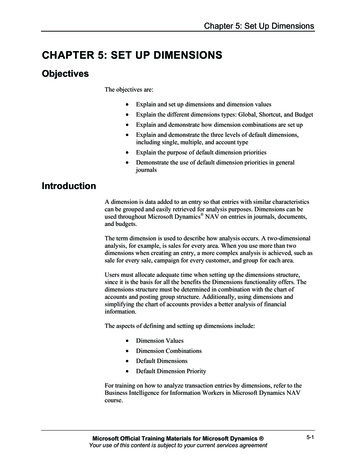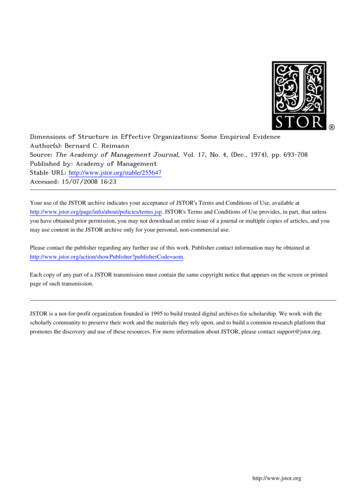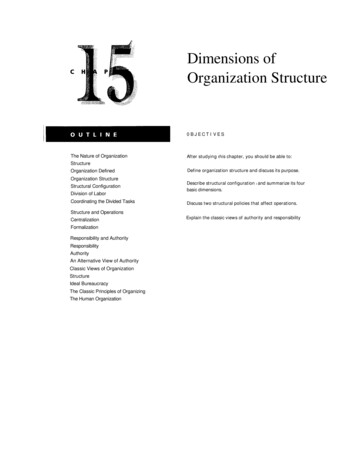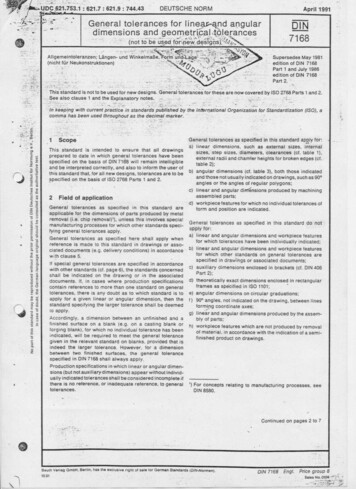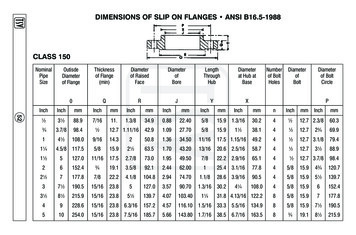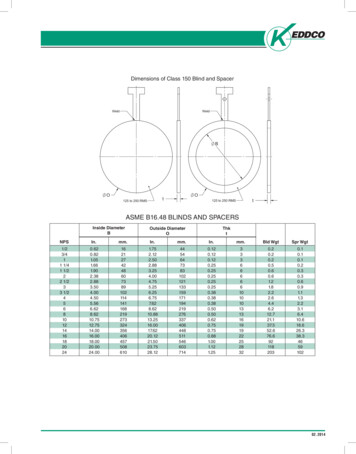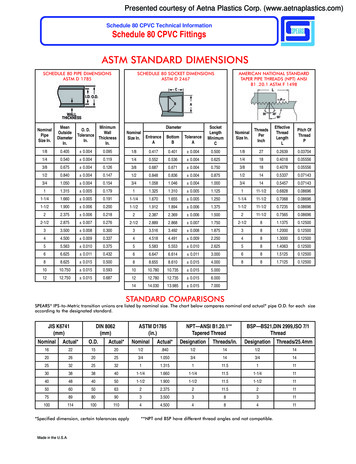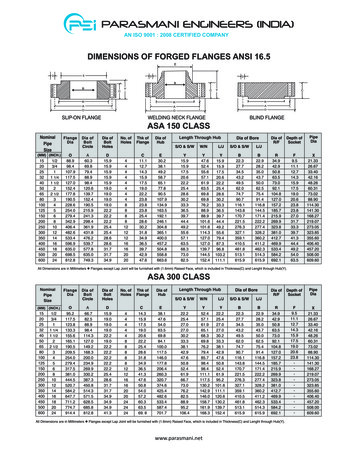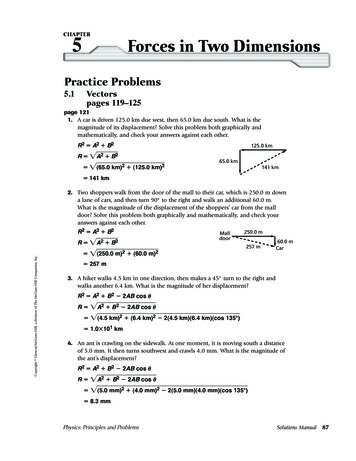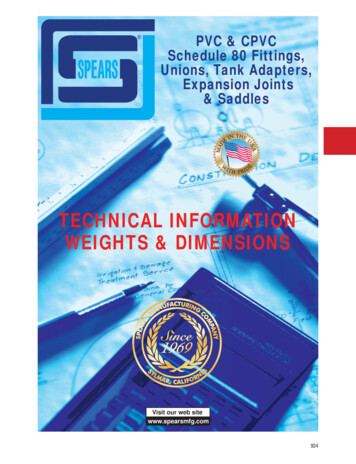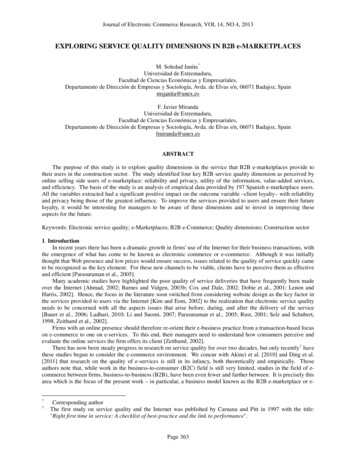
Transcription
Journal of Electronic Commerce Research, VOL 14, NO 4, 2013EXPLORING SERVICE QUALITY DIMENSIONS IN B2B e-MARKETPLACESM. Soledad Janita *Universidad de Extremadura,Facultad de Ciencias Económicas y Empresariales,Departamento de Dirección de Empresas y Sociología, Avda. de Elvas s/n, 06071 Badajoz, Spainmsjanita@unex.esF. Javier MirandaUniversidad de Extremadura,Facultad de Ciencias Económicas y Empresariales,Departamento de Dirección de Empresas y Sociología, Avda. de Elvas s/n, 06071 Badajoz, Spainfmiranda@unex.esABSTRACTThe purpose of this study is to explore quality dimensions in the service that B2B e-marketplaces provide totheir users in the construction sector. The study identified four key B2B service quality dimension as perceived byonline selling side users of e-marketplace: reliability and privacy, utility of the information, value-added services,and efficiency. The basis of the study is an analysis of empirical data provided by 197 Spanish e-marketplace users.All the variables extracted had a significant positive impact on the outcome variable –client loyalty– with reliabilityand privacy being those of the greatest influence. To improve the services provided to users and ensure their futureloyalty, it would be interesting for managers to be aware of these dimensions and to invest in improving theseaspects for the future.Keywords: Electronic service quality; e-Marketplaces; B2B e-Commerce; Quality dimensions; Construction sector1. IntroductionIn recent years there has been a dramatic growth in firms' use of the Internet for their business transactions, withthe emergence of what has come to be known as electronic commerce or e-commerce. Although it was initiallythought that Web presence and low prices would ensure success, issues related to the quality of service quickly cameto be recognized as the key element. For these new channels to be viable, clients have to perceive them as effectiveand efficient [Parasuraman et al., 2005].Many academic studies have highlighted the poor quality of service deliveries that have frequently been madeover the Internet [Ahmad, 2002; Barnes and Vidgen, 2003b; Cox and Dale, 2002; Dobie et al., 2001; Lenon andHarris, 2002]. Hence, the focus in the literature soon switched from considering website design as the key factor inthe services provided to users via the Internet [Kim and Eom, 2002] to the realization that electronic service qualityneeds to be concerned with all the aspects issues that arise before, during, and after the delivery of the service[Bauer et al., 2006; Ladhari, 2010; Li and Suomi, 2007; Parasuraman et al., 2005; Rust, 2001; Selz and Schubert,1998, Zeithaml et al., 2002].Firms with an online presence should therefore re-orient their e-business practice from a transaction-based focuson e-commerce to one on e-services. To this end, their managers need to understand how consumers perceive andevaluate the online services the firm offers its client [Zeithaml, 2002].There has now been steady progress in research on service quality for over two decades, but only recently 1 havethese studies begun to consider the e-commerce environment. We concur with Akinci et al. [2010] and Ding et al.[2011] that research on the quality of e-services is still in its infancy, both theoretically and empirically. Thoseauthors note that, while work in the business-to-consumer (B2C) field is still very limited, studies in the field of ecommerce between firms, business-to-business (B2B), have been even fewer and farther between. It is precisely thisarea which is the focus of the present work – in particular, a business model known as the B2B e-marketplace or e-*1Corresponding authorThe first study on service quality and the Internet was published by Caruana and Pitt in 1997 with the title:"Right first time in service: A checklist of best-practice and the link to performance".Page 363
Janita & Miranda: Exploring Service Quality Dimensions in B2B e-Marketplacesmarketplaces.When e-marketplaces first emerged, it was expected that they would improve the effectiveness and efficiency ofinter-firm business, radically changing traditional procurement strategies, and restructuring the firms themselves,their supply chains, and the industries they belong to. After this phase of euphoria, however, which lasted into thesecond half of the year 2000, many international e-marketplaces have failed, and their effectiveness in general hasbeen called into question [Balocco et al., 2010]. After this period of relative disappointment, Standing, et al. [2010],reviewed the literature on e-marketplaces, and found that there was an absence of research on aspects related to theirefficiency. It is this context, therefore, which formed the framework for the present study aimed at contributing tofilling this gap in research.In the context of B2C e-commerce, there has been extensive development of multi-item scales to measure thequality of e-services (see appendix A), but there is evidence that different priorities and experiences of corporatebuyer (B2B) and individual buyers (B2C) could lead service providers to perceive e-service quality differently in thetwo context [Turban et at., 2008]. However, in the B2B context, of the relatively far fewer studies on the topic, wewould highlight some original proposals to measure the quality of e-services [Chakraborty et al., 2005; Evans andKing, 1999; Vaidyanathan and Deveraj, 2008] and some adaptations of the traditional SERVQUAL scale,implementing slight modifications to fit it to the new context [Lai, 2006; Stiakakis and Georgiadis, 2009]A review of the literature on quality management in B2B e-commerce found no study addressing the context ofe-marketplaces, so that our principal objective in the present study was to explore and identify key underlyingdimensions of service quality provided by an e-marketplace to its users, and discover if there are differs significantlybetween to B2B y B2C context.We believe that any proposal of such a measuring instrument should add value to both researchers and emarketplace managers in the sense of allowing them to know which dimensions the users consider important in theirperception of the quality of the service offered.Following the structure proposed by Churchill [1979], the rest of this paper is organized as follows. In Sec. 2,we review the literature and conceptual definitions, we will specify the domain of the construct and we will generatethe sample of items, stopping to analyze what e-marketplaces are and how they work, and then examining qualitymanagement in e-services and putting forward our proposal of the main dimensions of perceived quality. In Sec. 3,we describe the methodology, we study the context and the sample selection, the Sec. 4, is dedicated to the dataanalysis, to assess the reliability and to validate the construct. Sec. 5 gives the conclusions drawn from thosefindings, finally, the Sec. 6 gives the limitations of the study and some lines for future research.2. Literature review and conceptual definitions2.1. B2B e-marketplacesThere is no clear consensus among authors on the definition of the e-marketplace [Grieger, 2003]. Some referto a place, a meeting point, or a location at which the transaction takes place [Ariba, 2000; Gulledge, 2002; Jensenand Skovgaard, 2001; Kaplan and Sawhney, 2000; Petersen et al., 2007; Segev et al. 1999; Stockdale and Standing,2002], others view it as a system of information about products or services [Bakos, 1991; Choudhury et al., 1998;Mueller, 2000], as an intermediary or business community [Bakos, 1998; Dai and Kauffman, 2002; Guo et al, 2012;Hoque, 2000; Jensen and Skovgaard, 2001; Lee et al, 2013; Yu et al. 2002], or as a medium that assigns differentroles to the members of the community and establishes conditions for participation [Grieger, 2003].We define the e-marketplace as a way of doing business that uses Internet technology to bring together multiplebuying and selling firms around a website or platform, enabling them to transact business through variousmechanisms, and directed either by a neutral third party outside the exchanges that take place, or by one or more ofthe parties involved [buyers or sellers]. It also offers various value-added services that improve relationshipsbetween buyers and sellers [Janita and Miranda, 2013].Research on e-marketplaces has shown that, in their early years, one of the principal motivations forparticipation was that they generated significant procurement cost savings. This naturally led to an increase in thereturn on investment (ROI) as a result of reducing paper transactions, allowing buyers to aggregate their demand andachieve significant economies of scale [Bakos, 1998; Barrat and Rosdahl, 2002; Christiaanse, 2005; Eng, 2004;Favier et al., 2000; Granot and Sosic, 2005; Kaplan and Sawhney, 2000; Min and Galle, 2003]. More recently, overthe last decade participants have shifted from short-term, price-based contracts towards achieving long-termtransactions, establishing collaborative relationships between buyers and sellers [Le, 2005]. The aim is now not onlycost savings, but also to improve the quality and integration of the various processes involved so as to achieveefficiencies in the supply chain [White et al. 2007].The various e-marketplaces can be classified according to their transactional content as vertical or horizontal[Balocco et al., 2010; Barrat and Rosdahl, 2002; Chien et al., 2012; Howard et al., 2006; Le, 2005; McIvor andPage 364
Journal of Electronic Commerce Research, VOL 14, NO 4, 2013Humphreys, 2004; Ratnasingam et al., 2005; Tapia, 2001]. Vertical e-marketplaces offer goods and services directlyrelated to the production process of a specific industrial sector, for example Agroterra (for the agriculture industry)or Plazasalud24 (for the healthcare and pharmaceutical industry). Horizontal e-marketplaces offer indirect goodsand services common to all industrial sectors, and necessary although not strategic to firms' activities in differentsectors of industrial activity [Lee, 2005; Popovic, 2002; Wang et al., 2012], for example Eventoplus.com (it offersservices and products related to events) or Adquira (it offers indirect goods and services such as: office supplies,cleaning and safety services, etc.).A second classification of e-marketplaces is in terms of ownership [Le, 2005; Kaplan and Sawhney, 2000;Ordanini and Pol, 2001;]. Partial or consortia e-marketplaces are those created and run by one of the participants(buyer or seller), for example Obralia (building and construction industry, created by buyers). Impartial e-marketsare those created and run by a neutral third party uninvolved in the exchanges that take place, for exampleMundoacero (steel industry).One can distinguish two types of market mechanism – static or systematic, and dynamic or unsystematic[Kaplan and Sawhney, 2000]. Static mechanisms are characterized by prices having been negotiated prior to theexchange and dynamic by prices being negotiated at the time of the exchange. The main static mechanisms are thecatalogue aggregation model and the buyer aggregation model. Examples of catalogue aggregation model includePlasticNet.com (plastic industry) and EcoSpainB2B (food and beverage industry). The main dynamic mechanismsare the call for quotations model, the auction model, and real-time exchanges. An example of marketplaces than usethe call for quotations is Mercatrans (for the transportation industry), the auction model is used by Aquanima (forthe multiples sectors] and real-time exchanges are used by Agromaquinaria (for the agriculture sector).2.2. E-services QualityThere is still no unanimous agreement in the literature on the concept of e-service, and in particular there is nodefinition of the term that is generally accepted by researchers.Some researchers stress what differentiates electronic from traditional services – above all, the lack of humaninteraction [Cox and Dale, 2001; Fassnacht and Koese, 2006]. For others, a definition of e-service should take intoaccount both its functional dimension –what is actually delivered as a result of the service– and its technicaldimension – how the service is delivered [Grönroos et al., 2000]. A complete definition of e-service should gobeyond mere commercial transactions (e-commerce) to take into account all the key processes and interactions thatare involved before, during, and after delivery of the services [Bauer et al., 2006; Parasuraman et al., 2005; Rust,2001; Rust and Lemon, 2001].One finds the first definition of e-service quality in Zeithaml et al. [2000, p.11]: "e-SQ can be defined as theextent to which a website facilitates efficient and effective shopping, purchasing, and delivery of products andservices." As one observes in recent research in the B2C context, academic interest has been directed to measuringthe quality of e-services [see Appendix A]. Indeed, the quality of e-services has become a key factor indifferentiating the services offered and in building a competitive advantage [Santos, 2003].From a review of the literature on e-service quality, we can say that at least there is unanimity amongresearchers about its multidimensionality [Kim and Stoel, 2004a; 2004b; Fassnacht and Koese, 2006]. The lack ofconsensus concerning the nature of e-service quality dimensions results in different approaches and outcomes aswell as the existence of research gaps [Fassnacht and Koese, 2006]. Therefore, the literature on e-service qualitycalls for its more complete and comprehensive understanding and conceptualization.We believe that the conceptualization of e-service quality should be based on the way customers judge it,considering the process (web site design, functionality and ease of use) and the service outcome. The processquality positively affects their perceptions of the outcome quality of the transaction and the quality of thetransaction’s outcome subsequently affects satisfaction evaluations.The critical question that arises, therefore, is which dimensions are the most important for the evaluation ofservice quality in e-commerce. To clarify this issue, we retrieved and consulted from the major existing databases(EBSCOhost, Emerald, ProQuest, and ScienceDirect) 104 articles published since 1997, the year in which the firstarticles appeared, corresponding to the principal researchers in this area. Most (89%) of these articles had beenpublished in the last nine years, most (85%) dealt with the B2C context, and just a few (8%) dealt with the area(B2B) that we are concerned with in the present study. The remainder dealt with the field of the connection betweengovernment agencies and consumers. Regarding the sectors addressed by the empirical works, most (59%) wereapplied to the online retail sector, mainly to the sale of discs, books, music, etc.Of the articles reviewed, 90 included scales to measure the quality of e-services (see Appendix A). Despite thelack of unanimity in the presentation of the different models, we found many similarities between the elements theyconsidered relevant for these measurements. Thus, Zeithaml et al. [2000, p.15] state: "Consumers use basicallysimilar dimensions in evaluating e-SQ (e-service quality) regardless of the type of product or service beingPage 365
Janita & Miranda: Exploring Service Quality Dimensions in B2B e-Marketplacesevaluated on the Internet." Most (70%) of the studies present original models: e-Selfqual proposed by Ding et al.[2011]; Netqual by Bressolles and Nantel [2008]; PesQ by Cristóbal et al. [2007]; WebQual or eQual by Barnes andVidgen [2001, 2006]; eTransqual by Bauer et al. [2006]; WebQual by Loiacono et al. [2002], etc. In 20% of thereviewed articles, the scales are based on the traditional American school –SERVQUAL, e-SERVQUAL, and E-SQual– in several cases with certain modifications. The remaining 10% use scales based on the work of otherresearchers.One area that is relatively under-researched in the service quality literature is B2B service quality and itsrelationships to perceived value and loyalty intentions. In the field of e-commerce, Anderson and Srinivasan [2003,p.125] define e-loyalty in a form similar to the definitions corresponding to the non-electronic environment as: “afavorable attitude of the customer towards the e-business resulting from repeated purchasing behavior.” A range ofstudies have shown a positive direct or indirect association through satisfaction or trust between service qualitydimensions and customer loyalty, with website design and associated usability factors being the most frequentfeatures reported (see [Valvi and West, 2013]). In the B2B context, a recent paper [Chen et al. 2013] posits thatprocess quality will significantly influence perceptions on satisfaction and customer loyalty. However there is a needto identify what attributes B2B users consider when judging the quality of service. Our research is positioned tocover this gap in research.It was clear from our literature review that most researchers consider the dimensions of efficiency, security andprivacy, communication, reliability, and information as components of e-service quality (see Figure 1). To thesedimensions, we shall add a new dimension which we term value-added services, considered in e-marketplaceresearch as being differentiating elements that help the firm achieve a competitive advantage [Ordanini and Pol,2001]. Mainly, they are services that complement the usual transactions of e-marketplaces. Among them, we wouldhighlight financial, logistics, and integrative services.In the following, we shall review the proposed principal dimensions of quality.Figure 1: Proposals of dimensions of quality.2.2.1. Information dimensionAlthough the classic IS success model [DeLone and Mc Lean, 2003] suggests that the information quality is adimension independent of the service quality, almost a 79% of the revised researches in e-commerce include theinformation inside the service quality.Many researchers recognize the importance of the characteristics that the information provided has to have forthe perception of service quality. In particular, the information needs to be trustworthy, in the sense how much canone trust in the information provided by the site, timely, relevant, easy to understand, with a high level of detail anddepth, sufficient, and presented in a suitable format [e.g., Barnes and Vidgen, 2002; Bressoles and Nantel 2008;Chakraborty et al., 2005; Fassnacht and Koese, 2006;]. For the client, it is important to be able to get adequateinformation about the product or service. The website should therefore provide the details that the client needs[Ranganathan and Ganapathy, 2002], including technical information in the B2B field [Chakraborty et al., 2005].Research has also shown the need to make information available about the firm, its history, its mission, its financialstatements, etc. [Kim et al., 2006], as well as about the industrial sector it belongs to [Chakraborty et al., 2005].Based on the work of Aladwani and Palvia [2002], Barnes and Vidgen [2002], Cox and Dale [2002], Janda et al.Page 366
Journal of Electronic Commerce Research, VOL 14, NO 4, 2013[2002], Loiacono et al. [2002], Yu et al. [2002], Kim and Stoel [2004a], Barrutia et al. [2006], Fassnacht and Koese[2006], and Boshoff [2007], we here propose the following seven-item scale:Q1: The e-marketplace's website provides information that is relevant and with a high level of detail anddepth.Q2: The website's content is clear, concise, easy to understand, well organized, and includes tutorials for itsuse.Q3: The website's content is up-to-date.Q4: The website's content is trustworthy.Q5: The website provides extensive information about my products and services, allowing them to be viewedand how to obtain more details about them.Q6: The website provides information about the e-marketplace, its activities, and the participating firms,both buyers and sellers.Q7: T
Page 365 Humphreys, 2004; Ratnasingam et al., 2005; Tapia, 2001. Vertical e] -marketplaces offer goods and services directly related to the production process of a specific industrial sector, for example (for the agriculture industry Agroterra ) or Plaza
